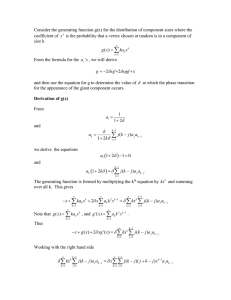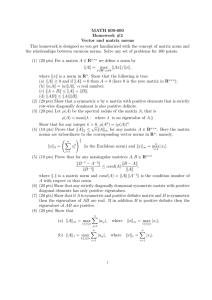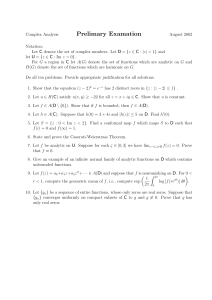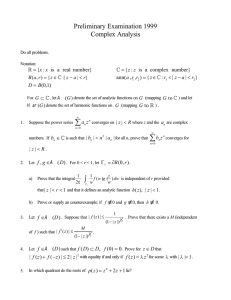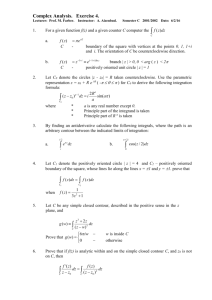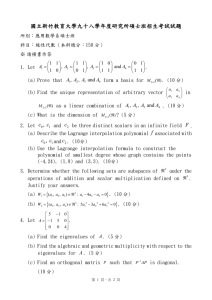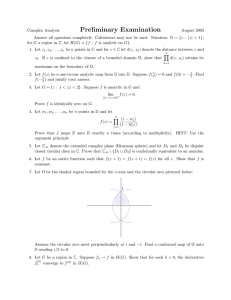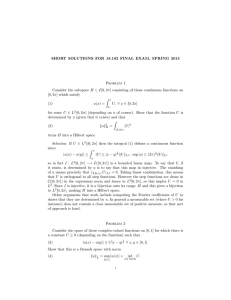NUMERICAL ANALYSIS QUALIFIER January, 2008
advertisement
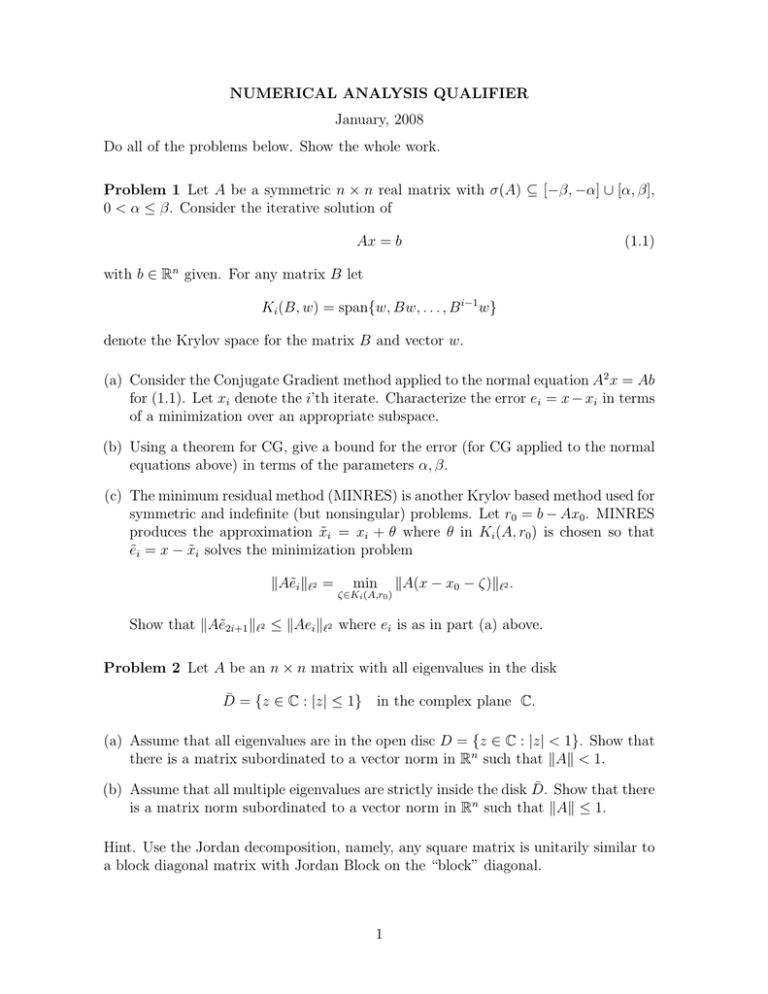
NUMERICAL ANALYSIS QUALIFIER
January, 2008
Do all of the problems below. Show the whole work.
Problem 1 Let A be a symmetric n × n real matrix with σ(A) ⊆ [−β, −α] ∪ [α, β],
0 < α ≤ β. Consider the iterative solution of
Ax = b
(1.1)
with b ∈ Rn given. For any matrix B let
Ki (B, w) = span{w, Bw, . . . , B i−1 w}
denote the Krylov space for the matrix B and vector w.
(a) Consider the Conjugate Gradient method applied to the normal equation A2 x = Ab
for (1.1). Let xi denote the i’th iterate. Characterize the error ei = x − xi in terms
of a minimization over an appropriate subspace.
(b) Using a theorem for CG, give a bound for the error (for CG applied to the normal
equations above) in terms of the parameters α, β.
(c) The minimum residual method (MINRES) is another Krylov based method used for
symmetric and indefinite (but nonsingular) problems. Let r0 = b − Ax0 . MINRES
produces the approximation x̃i = xi + θ where θ in Ki (A, r0 ) is chosen so that
ẽi = x − x̃i solves the minimization problem
kAẽi kℓ2 =
min
ζ∈Ki (A,r0 )
kA(x − x0 − ζ)kℓ2 .
Show that kAẽ2i+1 kℓ2 ≤ kAei kℓ2 where ei is as in part (a) above.
Problem 2 Let A be an n × n matrix with all eigenvalues in the disk
D̄ = {z ∈ C : |z| ≤ 1} in the complex plane C.
(a) Assume that all eigenvalues are in the open disc D = {z ∈ C : |z| < 1}. Show that
there is a matrix subordinated to a vector norm in Rn such that kAk < 1.
(b) Assume that all multiple eigenvalues are strictly inside the disk D̄. Show that there
is a matrix norm subordinated to a vector norm in Rn such that kAk ≤ 1.
Hint. Use the Jordan decomposition, namely, any square matrix is unitarily similar to
a block diagonal matrix with Jordan Block on the “block” diagonal.
1
Problem 3 Consider the Gaussian quadrature formula
Z 1
n
X
f (x)w(x)dx ≈
Ai f (xi ),
−1
i=0
where 0 < w(x) is an even function, i.e. w(x) = w(−x) for all x ∈ (−1, 1).
(a) Show that this formula is exact for all odd functions on [−1, 1], i.e. for functions
satisfying f (−x) = −f (x).
(b) Show that there is no other quadrature with n + 1 nodes even in the form
Z 1
n
n
X
X
f (x)w(x)dx ≈
ai f (xi ) +
bi f ′ (xi ),
−1
i=0
i=0
which has higher algebraic degree than the Gaussian formula.
Problem 4 Given u0i and u1i for i ∈ Z and k, h, b > 0 consider the Du Fort-Frankel
scheme
n
n
n+1
n−1
n+1
n
n−1
v n − 2vm
− vm−1
vm
− vm
vm
− 2vm
− vm
n
− m+1
+
= fm
,
2k
h2
h2
m∈Z
n
and n = 1, 2, . . . . With u0i , u1i and fm
appropriately chosen, the discrete solution
n
approximates the solution (vm
≈ u(mh, nk)) of the parabolic problem
ut − uxx = f (x, t) for x ∈ R,
u(x, 0) = g(x) for x ∈ R.
t > 0,
(a) Give a bound for the local truncation error associated with the above scheme;
(b) Using Fourier mode analysis, determine the stability properties of the above scheme.
Problem 5 Let Ω be a polygon R2 or a polyhedron in R3 . Let µ be a positive constant,
let β be a constant vector field, and let f ∈ L2 (Ω). Equip V = H01 (Ω) with the norm
v 7→ kvkV = k∇vkL2 and accept it as a fact that V thus equipped is a Hilbert space.
R
Consider Rthe problem: Seek u ∈ V such that, for all v ∈ V , a(u, v) = Ω f v, where
a(u, v) = Ω µ∇u·∇v + (β·∇u)v.
(a) Show that the above problem is well-posed.
(b) Let {Vh }h>0 be a family of finite-dimensional
R subspace of V . Let λ ≥ 0, define
the bilinear form aRh (wh , vh ) = a(wh , vh ) + λh Ω ∇wh ·∇vh , and let uh ∈ Vh be such
that ah (uh , vh ) = Ω f vh for all vh ∈ Vh . Set µh = µ + λh. Prove
R
∇vh ·∇wh kak
λh
Ω
sup
+ 1 + µh ku − vh kV .
ku − uh kV ≤ inf
µh
vh ∈Vh
kwh kV
wh ∈Vh
2
(c) Assume that there is an interpolation operator Πh such that kv−Πh vkV ≤ c hkvkH 2 (Ω)
for all v ∈ H 2 (Ω) ∩ V . Prove and comment the following estimate:
hkukH 2 + µλh hk∇ukL2 .
ku − uh kV ≤ c 1 + kak+λh
µh
Problem 6 (a) Let K = {(x, y) ∈ R2 ; 0 ≤ x, 0 ≤ y, x + y ≤ 1} be the reference
simplex. Denote the faces of K by F1 = {(x, y) ∈ K; x + y = 1}, F2 = {(x, y) ∈
K; x = 0}, F3 = {(x, y) ∈ K; y = 0}. Let P1 be the set ofR polynomials of total
1
p, i ∈ {1, 2, 3} and
degree at most 1. Consider the linear forms σi (p) := meas(F
i ) Fi
let Σ = {σ1 , σ2 , σ3 }. Prove that the finite element (K, P1, Σ) is unisolvent and find
the shape functions.
(b) Let Ω be a bounded polygon in R2 . Let {Th }h>0 be a family of conforming triangulations of Ω. Each mesh is composed of triangles. Let Fh be all faces of the
finite elements. Let F ∈ Fh be an interior face, i.e. there are two elements such
that F = K1 ∩ K2 ; for v ∈ C0 (K1 ) ∪ C0 (K2 ) denote by [v] := v|K1 − v|K2 the jump
across F .
Consider the space
Xh = {v; ∀K ∈ Th , v|K ∈ P1 , ∀F ∈ Fh ,
Z
[v] = 0}.
F
Let F ∈ FhRbe an interior face, F = K1 ∩ K2 . Denote by ϕF the function defined
as follows: F ′ ϕF = δF F ′ for all F ′ ∈ Fh . Here δF F ′ is 1 if F = F ′ and 0 if F 6= F ′ .
Prove that the set {ϕF }F ∈Fh is a basis for Xh .
(c) Let f ∈ L2 (Ω). Consider the following problem: Find uh ∈ Xh so that
Z
X Z
(uh vh + ∇uh ·∇vh ) =
f vh , ∀v ∈ Xh .
K∈Th
Ω
K
R
1
P
Consider the discrete norm kvk1,h = kvk2L2 + K∈Th K k∇vk2 2 . Prove that this
problem is well-posed in the k · k1,h -norm (i.e., there is a unique solution which is
stable with respect to the data).
3
